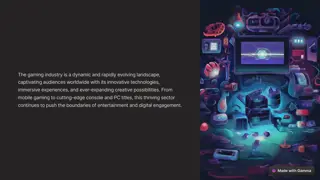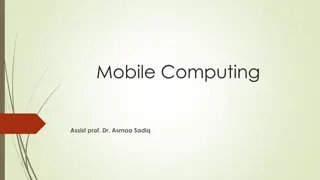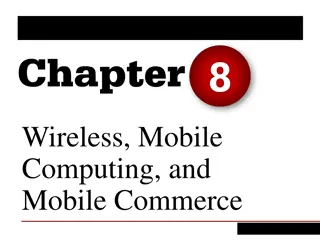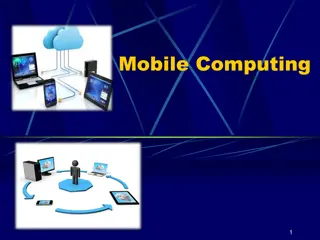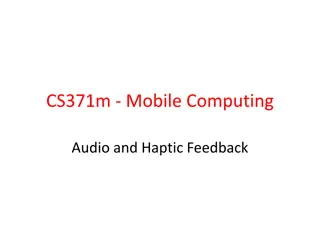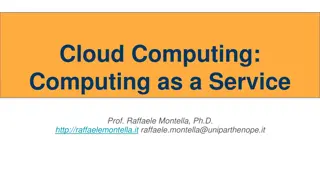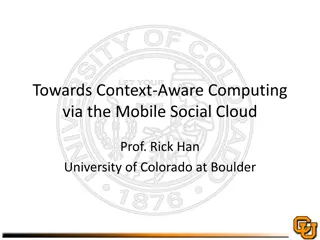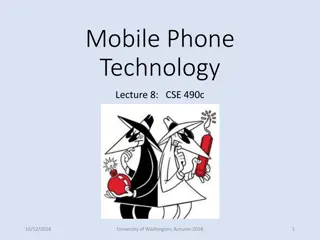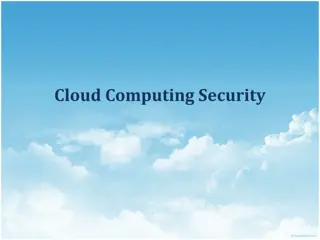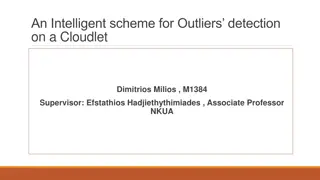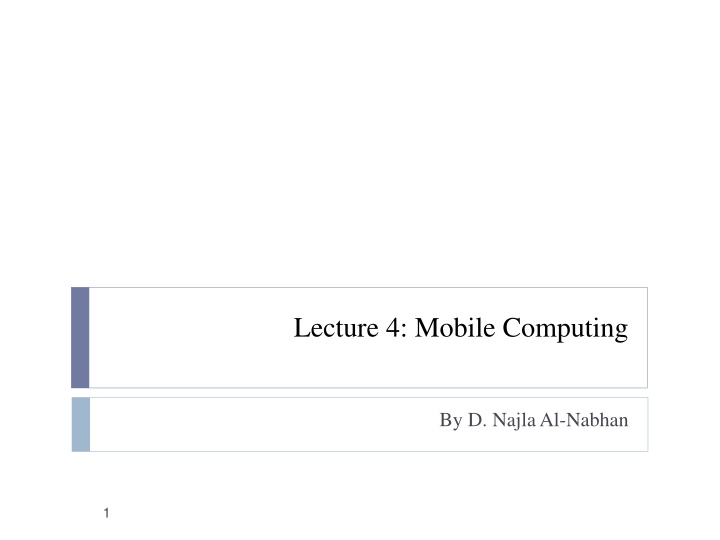
Mobile Computing: Overview and Applications
World of mobile computing with insights into its history, technology advances, aspects of mobility, integration of wireless networks, and application scenarios like smart mobile phones and vehicles. Discover the possibilities and importance of mobile computing in various sectors and environments."
Download Presentation

Please find below an Image/Link to download the presentation.
The content on the website is provided AS IS for your information and personal use only. It may not be sold, licensed, or shared on other websites without obtaining consent from the author. If you encounter any issues during the download, it is possible that the publisher has removed the file from their server.
You are allowed to download the files provided on this website for personal or commercial use, subject to the condition that they are used lawfully. All files are the property of their respective owners.
The content on the website is provided AS IS for your information and personal use only. It may not be sold, licensed, or shared on other websites without obtaining consent from the author.
E N D
Presentation Transcript
Lecture 4: Mobile Computing By D. NajlaAl-Nabhan 1
Overview What is it? Who needs it? History Future 2
A computer in 2014? Advances in technology More computing power in smaller devices Flat, lightweight displays with low power consumption New user interfaces due to small dimensions More bandwidth (per second? per space?) Multiple wireless techniques Technology in the background of mobile computing Device location awareness: computers adapt to their environment User location awareness: computers recognize the location of the user and react appropriately (call forwarding, service allocation) Computers evolve Small, cheap, portable, replaceable Integration or disintegration? 3
What is Mobile Computing? Aspects of mobility User mobility: users communicate anytime, anywhere, with anyone (example: read/write email on web browser) Device portability: devices can be connected anytime, anywhere to the network 4
What is Mobile Computing? The demand for mobile communication creates the need for integration of wireless networks and existing fixed networks, such as Local area networks Wide area networks Internet: Mobile IP extension of the Internet protocol IP 5
Application Scenarios Vehicles Smart mobile phone Invisible computing Wearable computing Intelligent house or office Meeting room/conference Taxi/Police/Fire squad fleet Service worker Disaster relief and Disaster alarm Games Military / Security What is important? 6
Vehicles 7
Smart mobile phone Mobile phones get smarter Converge with PDA? Voice calls, video calls Email or instant messaging Play games Up-to-date localized information Map Finding Services ( Ask: Find the next Pizzeria, answer: Hey, we have great Pizza! ) Stock/weather/sports info Ticketing 8
Invisible/ubiquitous/pervasive and wearable computing Tiny embedded computers Everywhere 9
Intelligent Office and Intelligent House Bluetooth replaces cables Plug and play, without the plug Again: Find the local printer House recognizes resident House regulates temperature according to person in a room Home without cables looks better LAN in historic buildings 10
Meeting room or Conference Share data instantly Send a message to someone else in the room Secretly vote on controversial issue Find person with similar interests Broadcast last minute changes Ad-Hoc Network 11
Taxi / Police / Fire squad / Service fleet Connect Control Communicate Service Worker Example.. 12
Disaster relief After earthquake, tsunami, volcano, etc: You cannot rely on infrastructure but you need to orchestrate disaster relief Early transmission of patient data to hospital Satellite Ad-Hoc network 13
Disaster alarm With sensors you might be able to alarm early Example: Tsunami Example: Cooling room Or simpler: Weather station Satellite Ad-Hoc network 14
Games Nintendo Gameboy [Advance]: Industry standard mobile game station Connectable to other Gameboys Can be used as game pad for Nintendo GameCube 15
Military / Security From a technology standpoint this is similar to disaster relief US army is the best costumer 16
Effect of Device Portability: Challenges Energy consumption limited computing power, low quality displays, small disks Limited memory (no moving parts) Radio transmission has a high energy consumption CPU: power consumption Limited user interfaces compromise between size of fingers and portability integration of character/voice recognition, abstract symbols Loss of data higher probability (e.g., defects, theft) 18
Wireless networks in comparison to fixed networks Wireless networks has : Higher loss-rates due to interference Restrictive regulations of frequencies Low transmission rates . Higher delays, more jitter Lower security, simpler active attacking Always shared medium 19
Lecture 5: Mobile Computing Part-II By D. Najla Al-Nabhan 20
History of Wireless Technologies Development (1980-200?) 21
EXISTING CELLULAR NETWORK ARCHITECTURE A cellular network consists of mobile units linked together to switching equipment, which interconnect the different parts of the network and allow access to the fixed Public Switched Telephone Network (PSTN). It's incorporated in a number of transceivers called Base Stations (BS). Every BS is located at a strategically selected place and covers a given area or cell - hence the name cellular communications. A number of adjacent cells grouped together form an area and the corresponding BSs communicate through a so called Mobile Switching Centre (MSC). 22
EXISTING CELLULAR NETWORK ARCHITECTURE The MSC is the heart of a cellular radio system. MSC is responsible for routing, or switching, calls from the originator to the destination. managing the cell, for set-up,routing control and termination of the call, for management of inter-MSC hand over and supplementary services, and for collecting charging and accounting information. The MSC may be connected to otherMSCs or to the PSTN. 23
Mobile communication overview Each cell has a number of channels associated with it. When a Mobile Station (MS) becomes 'active' it registers with the nearest BS. The corresponding MSC stores the information about that MS and its position. This information is used to direct incoming calls to the MS. If during a call the MS moves to an adjacent cell then a change of frequency will necessarily occur - since adjacent cells never use the same channels. This procedure is called hand over and is the key to Mobile communications. 24
History of Wireless Technologies Development (1980-200?) 25
The Future With the emphasis increasingly on compact, small mobile computers, it may also be possible to have all the practicality of a mobile computer in the size of a hand held organizer or even smaller. With the rapid technological advancements in Artificial Intelligence, Integrated Circuitry and increases in Computer Processor speeds, the future of mobile computing looks increasingly exciting. Use of Artificial Intelligence may allow mobile units to be the ultimate in personal secretaries, which can receive emails and paging messages, understand what they are about, and change the individuals personal schedule according to the message. The working lifestyle will change, with the majority of people working from home, rather than commuting. This may be beneficial to the environment as less transportation will be utilized. 27
The Future As shown in the figure, trends are very much towards ubiquitous or mobile computing. Interactive television, Video Image Compression, mobility in the home, ie. home shopping etc. this mobility may be pushed to extreme. The future of Mobile Computing is very promising indeed, although technology may go too far, causing big changes to society. 28

